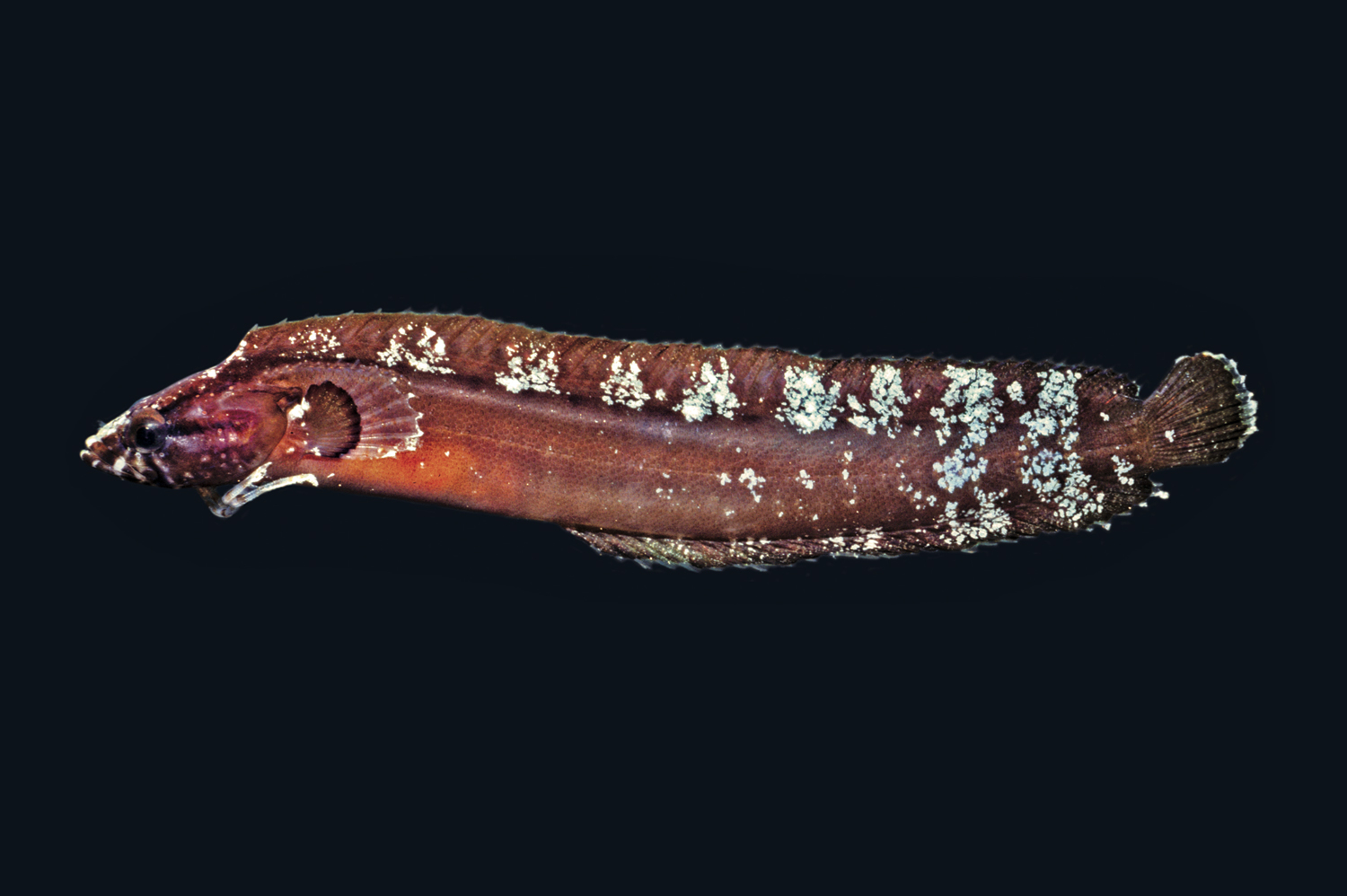- Classification
- ACTINOPTERYGII
- PERCIFORMES
- CLINIDAE
- Ophiclinus
- pectoralis
Whiteblotch Snake Blenny, Ophiclinus pectoralis George & Springer 1980
Other Names: Slender Snake Blenny, Whiteblotch Snakeblenny

A Whiteblotch Snake Blenny, Ophiclinus pectoralis. Source: Rudie H. Kuiter / Aquatic Photographics. License: All rights reserved
Summary:
A brown snake blenny, with a mottled area extending length of body, often reaching onto the dorsal, anal and caudal fins (some individuals are only mottled posteriorly, sometimes a pale stripe on top of the head and body, occasionally with a series of pale and dark spots along the back, a prominent dark band extending ventrally from each eye, a second band extending from the rear of the eye, dusky dorsal and anal fins with transparent margins and several slightly darker bands posteriorly, a dark brown caudal fin with a transparent margin and pale speckling, and the basal one-fourth of the pectoral fins dark brown, outer portion clear.
Cite this page as:
Bray, D.J. 2022, Ophiclinus pectoralis in Fishes of Australia, accessed 01 Jul 2025, https://fishesofaustralia.net.au/Home/species/1108
Whiteblotch Snake Blenny, Ophiclinus pectoralis George & Springer 1980
More Info
|
Distribution |
Endemic to south-western Western Australia from the Recherche Archipelago to Rottnest Island. Inhabits shallow rocky, weedy and sandy areas. |
|
Features |
Dorsal fin XLII-XLIV, 1; Anal fin II, 25-28; Caudal fin 13; Pectoral fin 11-12.; Pelvic fin I, 2. Body shallow (15-16% SL). Head small (22-23%, SL); eyes small (18-19% HL); tube of anterior nostrils with fleshy flap at tip; mouth small (upper jaw length 33-34% HL), nearly horizontal, maxillae reaching just beyond centre of eyes; roof of mouth with curved row of teeth. Lateral line consisting of 14-18 pores originating above each opercle, followed by series of pit-like depressions; front pore in series of pores running down and forward on each cheek usually paired. Dorsal fin arising above rear of opercles, membrane between anal fin rays distinctly notched at edge; caudal fin rounded. Pectoral fins of moderate size, much longer than eye diameter. Pelvic fins much longer than eye diameter, arising slightly in front of and below pectoral fin bases. |
|
Colour |
Brown, mottled with white posteriorly, mottled area extending length of body in some, often reaching onto dorsal, anal and caudal fins, mid-dorsal stripe on head and body sometimes pale, occasionally with series of pale and dark spots on dorsal margin of sides; prominent dark band extending ventrally from each eye, a second posteriorly; dorsal and anal fins dusky with clear margins and several slightly darker bands posteriorly caudal fin dark brown with clear margin and pale speckling; basal one-fourth of pectoral fins dark brown, outer portion clear. |
|
Biology |
Viviparous - internal fertilisation and females give birth to live young. |
|
Similar Species |
The distinct colour pattern of Ophiclinus pectoralis readily distinguishes it from all other species of Ophiclinus. |
|
Etymology |
The specific name is from the Latin pectoralis (= of the breast), in reference to the distinctive colour pattern on the pectoral fins (the dark anterior part sharply demarcated from the transparent to white posterior part). |
|
Species Citation |
Ophiclinus pectoralis George & Springer 1980, Smithson. Contrib. Zool. 307: 23, figs 11, 12. Type locality: Bay on northeastern side of Sandy Hook Island, Recherche Archipelago, Western Australia, 34°01'S, 122°00'E, depth 13 m. |
|
Author |
Bray, D.J. 2022 |
|
Resources |
Whiteblotch Snake Blenny, Ophiclinus pectoralis George & Springer 1980
References
George, A. & Springer, V.G. 1980. Revision of the clinid fish tribe Ophiclinini, including five new species, and definition of the family Clinidae. Smithsonian Contributions to Zoology 307: 1-31 figs 1-14 https://doi.org/10.5479/si.00810282.307
Gomon, M.F., Glover, C.J.M. & Kuiter, R.H. (eds) 1994. The Fishes of Australia's South Coast. Adelaide : State Printer 992 pp. 810 figs.
Hoese, D.F., Gomon, M.F. & Rennis, D.S. 2008. Family Clinidae. pp. 696-722 in Gomon, M.F., Bray, D.J. & Kuiter, R.H. (eds) Fishes of Australia's Southern Coast. Sydney : Reed New Holland 928 pp.
Holleman, W., Williams, J.T. & Clements, K.D. 2014. Ophiclinus pectoralis. The IUCN Red List of Threatened Species 2014: e.T179025A1560838. http://dx.doi.org/10.2305/IUCN.UK.2014-3.RLTS.T179025A1560838.en. Downloaded on 25 March 2017.
Hoschke, A., Whisson, G. & Moore, G.I. 2019. Complete list of fishes from Rottnest Island. pp. 150-161 in Whisson, G. & Hoschke, A. (eds) The Rottnest Island fish book. 2nd ed. Perth : Aqua Research and Monitoring Services.
Hoschke, A., Whisson, G. & Moore, G.I. 2021. Complete list of fishes recorded from the Perth Coast (Mandurah to Two Rocks). pp. 262-273 in Whisson, G. & Hoschke, A. (eds) The Perth coast fish book. Identification guide Mandurah to Two Rocks. Perth : Aqua Research and Monitoring Services.
Rennis, D., Hoese, D.F. & Gomon, M.F. 1994. Family Clinidae. pp. 741-775, figs 650-684B in Gomon, M.F., Glover, C.J.M. & Kuiter, R.H. (eds) The Fishes of Australia's South Coast. Adelaide : State Printer 992 pp. 810 figs.



